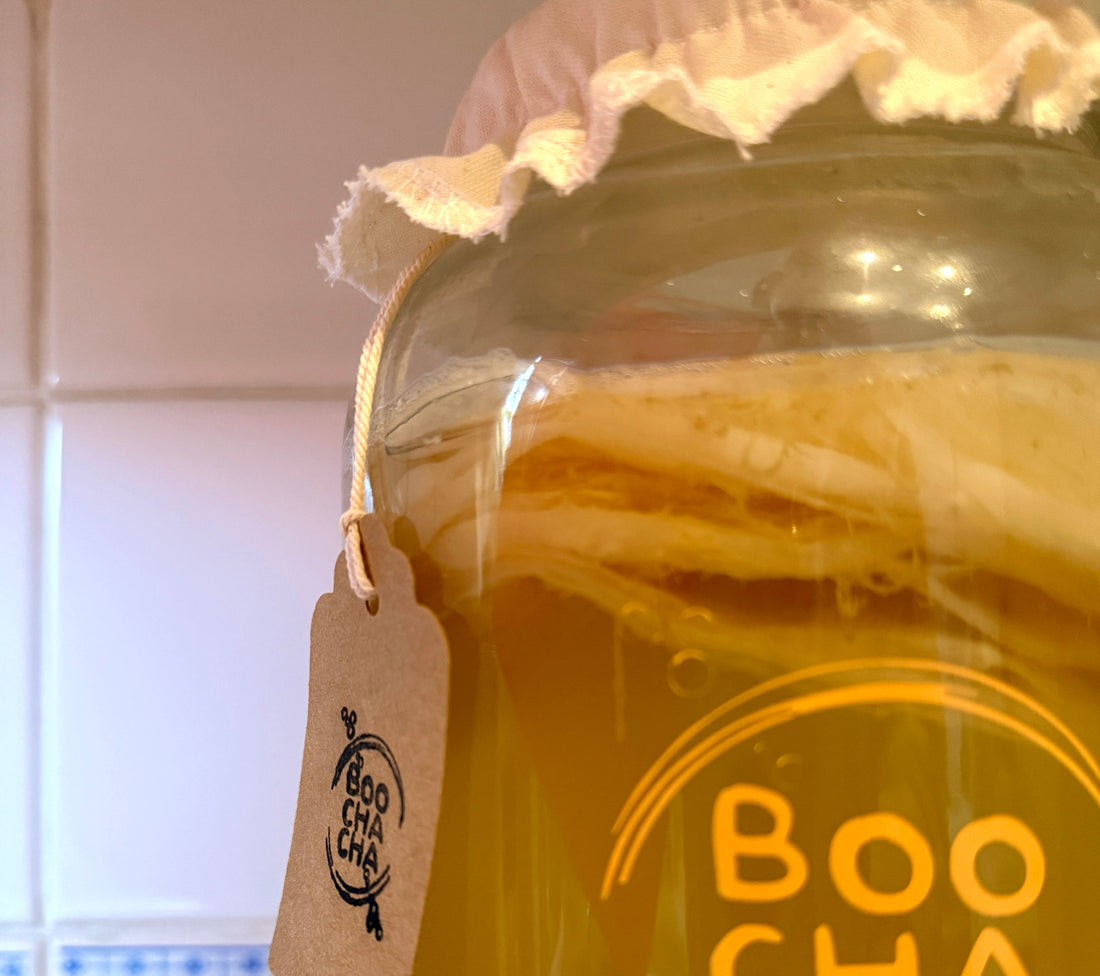If you’ve been making Kombucha for a little while, you’ve probably noticed something fascinating. Every time you brew a batch, your SCOBY seems to change shape, thicken, or even produce a whole new layer.
For beginners, this can be a little puzzling, and it often leads to one important question: how long will my SCOBY last?
The short answer is that, with the right care (which is easy), your SCOBY can last forever (isn't that wild)!

If you've never seen a SCOBY before, take a look at our Kombucha SCOBY Gallery here.
If you already know you're ready to be the responsible owner of a new baby SCOBY, then we have a Kombucha Starter Kit waiting for you. Our kits are famous for their juicy SCOBYs, for making delicious Kombucha right from the first brew and for being rated 5 stars for beginners (by beginners).
Your SCOBY is a living culture that keeps regenerating over and over again. In fact, over a lifetime of brewing, you might find yourself with more SCOBY's than you know what to do with (but don't worry, we have plenty of fun ideas for your spares).
Let’s take a closer look at what your SCOBY actually does, how long you can expect yours to last, and some of the fun and practical things you can do with extra ones.
What is a SCOBY?
First, let's talk about what a SCOBY actually is. SCOBY stands for Symbiotic Culture Of Bacteria and Yeast. It’s a cellulose structure that forms on the surface of your brew as a biproduct of the fermentation.
You cannot make authentic Kombucha without a SCOBY to kick the fermentation off, and it's very important that you get a good amount of powerful starter liquid alongside the cellulose chunk. We have more information on that topic, and instructions on how you can grow your own SCOBY too, here.
As you brew each batch of Kombucha, you'll notice new SCOBY layers forming on the surface of the liquid. These new layers are a great sign and they indicate a healthy, thriving Kombucha brew.
When we talk about these new layers to beginners, we like to simplify it by describing their growth as your proof that the live bacteria within your brew are consuming the sugar added to the brew. It is a basic exchange, add the sugar to fuel the fermentation, and the fermentation magic will produce a physical sign that something is happening; your new SCOBY layers. Simples.
Your SCOBY is a living thing (just like a pet), and like many living things, it can renew itself (and it deserves a name).

New Layers
Every time you brew Kombucha, your SCOBY will start to form a new layer, to fill the shape of whatever you are brewing in. New layers always form on the top, and the older layers get pushed down further into the liquid.
The top layer is the newest and usually the freshest / whitest in colour, while the lower layers may be darker from contact with the tea and from absorbing more of the acids over time.
This constant regeneration is one reason SCOBYs can last you a lifetime, so let's get into that a little bit more.
So How Long Does My SCOBY Last For?
In ideal conditions, a SCOBY can be used indefinitely. It doesn’t have an expiration date in the traditional sense. But it does need a very small amount of care and attention.
What matters is keeping it healthy. A healthy SCOBY will be firm, slightly rubbery, and light to medium beige in colour. It should have a clean, slightly vinegary smell, with no signs of mould, BUT ...
... one of the best things about brewing Kombucha, is how easy it is to spot when it has gone wrong! Mould always grows on the top surface of your SCOBY and is dry / fluffy / powdery looking. See examples of mouldy SCOBYs here.
If you take care of your brewing environment, by keeping everything clean, using the right tea and sugar, and protecting the brew from contaminants – your SCOBY will keep producing new batches again and again.
There are stories of families passing SCOBYs down through generations, like family heirlooms. Legend has it that all of the SCOBYs, and hence all Kombucha, comes from one original SCOBY formed by a freak accident (leaving a cold cup of sweet tea out to be contaminated by bacteria) around 2000 years ago!
Of course, like any living thing, a SCOBY can suffer from neglect or unsuitable conditions.
Extreme heat or cold can stress the culture, and brewing with teas that contain oils (like Earl Grey with bergamot) or artificial sweeteners can harm it. Mould is one of the few things that can truly ruin a SCOBY, and if mould appears, the safest option is to discard the whole brew, and start again.
Your SCOBY will not “wear out” in the way some fermentation cultures do, and they can be left without a 'feed' / refill of sweet tea for up to 8 weeks, which makes Kombucha the perfect ferment for people who like holidays!

Too Many Kombucha SCOBYs
When to split your Kombucha SCOBY?
We always recommend beginners start out with the continuous Kombucha brew method. This method is much easier than batch brewing, and reduces the risks of contamination too.
This basically means that you simply leave your SCOBY to grow continuously in your main fermentation vessel, and you refill with sweet tea every time you remove a batch of Kombucha (super helpful to have a tap on your fermentation vessel).
You can imagine that over time, because your SCOBY produces a new layer every time you brew, you eventually (around 6 months of continuous brewing normally) end up with too much SCOBY (and perhaps no more room for liquid).
This is a good time to split off some of the older layers.
The other reason you could split some layers off, is if your Kombucha is fermenting too fast.
Some brewers set-up a SCOBY hotel, which is just another big jar with some strong Kombucha and they add their spare SCOBYs into there, to save as a backup. You don't really need one of these as a regular home brewer, but if you want more info on this, here's our blog on SCOBY hotels.
Using Up Spare SCOBYs
This is where the fun begins, because extra SCOBYs are surprisingly versatile. Our first option is always to share them with friends and family who want to start brewing their own Kombucha.
They make great gifts for fellow fermenters, and it’s so fun to pass on knowledge to someone you love, and to help them discover the wonder of homemade Kombucha. Here's a blog on splitting your SCOBY and passing it to a friend.
But sharing isn’t the only option. SCOBYs are edible, and some people use them as an ingredient in cooking. Because they’re made of cellulose, they have a chewy, slightly rubbery texture, not unlike a very thick mushroom or a piece of soft, flexible leather.
You can cut them into strips and marinate them in soy sauce, vinegar, or spices to make a chewy snack, similar to vegan jerky. You can blend them into smoothies for a probiotic boost, though the texture can be unusual if you’re not expecting it. You can even candy SCOBYs by simmering them in sugar syrup and letting them dry, creating a tangy, chewy sweet.
But if eating your SCOBY isn't appealing, we have loads of other fun ideas too!
SCOBY Skincare
SCOBYs are naturally cool, hydrating, and rich in nutrients that can help reduce puffiness, hydrate under-eye skin, and soften fine lines.
Our SCOBY skincare blog has loads of recipes and ideas for natural skincare, my favourite is the SCOBY face mask mixed with tea tree oil. It makes my skin SO SOFT.
Fruit Winders Recipe
If you’re into experimental food, SCOBYs can also be dehydrated into a flexible sheet that’s just like a fruity winder (the totally natural version). This can be flavoured with blended fruit, herbs, or spices before drying to create a unique, probiotic-rich snack.
We have a full blog for this fun recipe here.
Vegan Leather
Some creatives have even used dried SCOBY sheets as a base for vegan leather, experimenting with them in textiles and art projects.
The smooth, durable surface of a dried SCOBY can be cut, stitched, and shaped, making it a fascinating material for crafting.
Gardening
Gardeners also find uses for spare SCOBYs.
Because they’re made of organic matter and full of beneficial acids, they can be composted to enrich soil.
Some people even chop them up and bury them directly in garden beds as a slow-release fertilizer. The microbes won’t survive for long once outside the brewing environment, but the material itself will break down and feed your plants.
Chickens and some other animals will happily eat SCOBYs as well, though it’s wise to introduce it slowly to their diet to see how they respond.
 It’s worth noting that SCOBYs do change over time. Older layers can become quite dark and thick, and while they’re still functional, they can sometimes make the Kombucha taste stronger, almost vinegar-like.
It’s worth noting that SCOBYs do change over time. Older layers can become quite dark and thick, and while they’re still functional, they can sometimes make the Kombucha taste stronger, almost vinegar-like.
Many brewers prefer to use younger SCOBYs or peel away the older layers from the bottom every so often to keep flavours fresh. But even an older SCOBY isn’t useless, it is perfect for all the ideas listed above, now you just have to decide which to try first!
It is because of the SCOBY that Kombucha brewing has spread so widely among home fermenters and health enthusiasts, it’s easy to share, and the culture is endlessly renewable.
So, how long will your SCOBY last? The answer is: as long as you want it to. It’s a living, growing thing, and as long as you feed it and keep it healthy, it will keep rewarding you.
Most brewers find that managing the abundance of SCOBYs becomes part of the fun!
In the end, your SCOBY isn’t just the heart of your Kombucha brewing, it’s a renewable resource, for both Kombucha brewing and much more!


